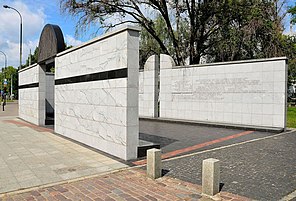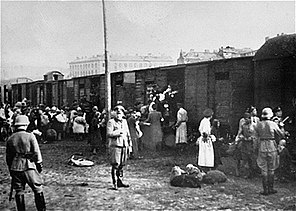Umschlagplatz
| Umschlagplatz of the Warsaw Ghetto | |
|---|---|

National monument at the Ghetto's former Umschlagplatz symbolizing an open freight car, Stawki Street, Warsaw
|
|

Polish Jews loaded onto trains at the Warsaw Ghetto
|
The Umschlagplatz (German: collection point or reloading point) was a holding area set up by Nazi Germany adjacent to a railway station in occupied Poland, where the ghettoised Jews were assembled for deportation to death camps during the ghetto liquidation. The largest such collection point consisted of a city square in occupied Warsaw next to the Warsaw Ghetto, used for several months during daily deportations of 254,000 – 265,000 Warsaw Jews to the Treblinka extermination camp. A monument was erected in 1988 on Stawki Street, where the Umschlagplatz was located, to commemorate the deportation victims. Another prominent example included the Radogoszcz station Umschlagplatz adjacent to the Łódź Ghetto where prisoners were brought under military escort for deportations directly to Chełmno (Kulmhof) and Auschwitz extermination camps.
For logistical reasons, the victims awaiting the arrival of Holocaust trains were often kept at the Umschlagplatz overnight during Operation Reinhard, the deadliest phase of the Holocaust in Poland. The same term in the German language is used commonly to denote a place where all goods for rail transport are handled.
During the Grossaktion Warsaw, which began on 22 July 1942, Jews were deported in crowded freight cars to Treblinka twice daily, in the early morning, often after an overnight wait, and in mid-afternoon. On some days as many as 10,000 Jews were deported. An estimated 300,000 Jews were taken to the Treblinka gas chambers; some sources describe it as the largest killing of a community in World War II. The mass deportation action ended on 21 September 1942, although trains to Treblinka continued to depart from 19 April 1943 until the end of the Warsaw Ghetto Uprising in 1943.
...
Wikipedia
